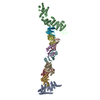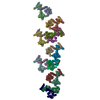+ Open data
Open data
- Basic information
Basic information
| Entry | Database: PDB / ID: 7b70 | |||||||||
|---|---|---|---|---|---|---|---|---|---|---|
| Title | TRAPPCore plus C8 (355-596) and C11 (1-718) from MiniTRAPPIII | |||||||||
 Components Components |
| |||||||||
 Keywords Keywords | EXOCYTOSIS / Rab1 / GEFs / Golgi / TRAPP complexes | |||||||||
| Function / homology |  Function and homology information Function and homology informationCOPII-mediated vesicle transport / RAB GEFs exchange GTP for GDP on RABs / TRAPPI protein complex / TRAPPII protein complex / TRAPPIII protein complex / TRAPP complex / cis-Golgi network membrane / Golgi vesicle transport / Neutrophil degranulation / cis-Golgi network ...COPII-mediated vesicle transport / RAB GEFs exchange GTP for GDP on RABs / TRAPPI protein complex / TRAPPII protein complex / TRAPPIII protein complex / TRAPP complex / cis-Golgi network membrane / Golgi vesicle transport / Neutrophil degranulation / cis-Golgi network / intra-Golgi vesicle-mediated transport / protein secretion / endoplasmic reticulum to Golgi vesicle-mediated transport / long-term memory / intracellular transport / vesicle-mediated transport / trans-Golgi network / nervous system development / spermatogenesis / perinuclear region of cytoplasm / endoplasmic reticulum / Golgi apparatus / nucleus / cytosol / cytoplasm Similarity search - Function | |||||||||
| Biological species |  | |||||||||
| Method | ELECTRON MICROSCOPY / single particle reconstruction / cryo EM / Resolution: 4 Å | |||||||||
 Authors Authors | Galindo, A. / Munro, S. / Planelles-Herrero, V.J. | |||||||||
 Citation Citation |  Journal: EMBO J / Year: 2021 Journal: EMBO J / Year: 2021Title: Cryo-EM structure of metazoan TRAPPIII, the multi-subunit complex that activates the GTPase Rab1. Authors: Antonio Galindo / Vicente J Planelles-Herrero / Gianluca Degliesposti / Sean Munro /  Abstract: The TRAPP complexes are nucleotide exchange factors that play essential roles in membrane traffic and autophagy. TRAPPII activates Rab11, and TRAPPIII activates Rab1, with the two complexes sharing a ...The TRAPP complexes are nucleotide exchange factors that play essential roles in membrane traffic and autophagy. TRAPPII activates Rab11, and TRAPPIII activates Rab1, with the two complexes sharing a core of small subunits that affect nucleotide exchange but being distinguished by specific large subunits that are essential for activity in vivo. Crystal structures of core subunits have revealed the mechanism of Rab activation, but how the core and the large subunits assemble to form the complexes is unknown. We report a cryo-EM structure of the entire Drosophila TRAPPIII complex. The TRAPPIII-specific subunits TRAPPC8 and TRAPPC11 hold the catalytic core like a pair of tongs, with TRAPPC12 and TRAPPC13 positioned at the joint between them. TRAPPC2 and TRAPPC2L link the core to the two large arms, with the interfaces containing residues affected by disease-causing mutations. The TRAPPC8 arm is positioned such that it would contact Rab1 that is bound to the core, indicating how the arm could determine the specificity of the complex. A lower resolution structure of TRAPPII shows a similar architecture and suggests that the TRAPP complexes evolved from a single ur-TRAPP. | |||||||||
| History |
|
- Structure visualization
Structure visualization
| Movie |
 Movie viewer Movie viewer |
|---|---|
| Structure viewer | Molecule:  Molmil Molmil Jmol/JSmol Jmol/JSmol |
- Downloads & links
Downloads & links
- Download
Download
| PDBx/mmCIF format |  7b70.cif.gz 7b70.cif.gz | 390.1 KB | Display |  PDBx/mmCIF format PDBx/mmCIF format |
|---|---|---|---|---|
| PDB format |  pdb7b70.ent.gz pdb7b70.ent.gz | 314.4 KB | Display |  PDB format PDB format |
| PDBx/mmJSON format |  7b70.json.gz 7b70.json.gz | Tree view |  PDBx/mmJSON format PDBx/mmJSON format | |
| Others |  Other downloads Other downloads |
-Validation report
| Summary document |  7b70_validation.pdf.gz 7b70_validation.pdf.gz | 986.5 KB | Display |  wwPDB validaton report wwPDB validaton report |
|---|---|---|---|---|
| Full document |  7b70_full_validation.pdf.gz 7b70_full_validation.pdf.gz | 1.1 MB | Display | |
| Data in XML |  7b70_validation.xml.gz 7b70_validation.xml.gz | 79.8 KB | Display | |
| Data in CIF |  7b70_validation.cif.gz 7b70_validation.cif.gz | 120.5 KB | Display | |
| Arichive directory |  https://data.pdbj.org/pub/pdb/validation_reports/b7/7b70 https://data.pdbj.org/pub/pdb/validation_reports/b7/7b70 ftp://data.pdbj.org/pub/pdb/validation_reports/b7/7b70 ftp://data.pdbj.org/pub/pdb/validation_reports/b7/7b70 | HTTPS FTP |
-Related structure data
| Related structure data |  12063MC  7b6dC  7b6eC  7b6hC  7b6rC  7b6xC  7b6yC  7b6zC C: citing same article ( M: map data used to model this data |
|---|---|
| Similar structure data |
- Links
Links
- Assembly
Assembly
| Deposited unit | 
|
|---|---|
| 1 |
|
- Components
Components
-Trafficking protein particle complex ... , 5 types, 6 molecules AGCDFJ
| #1: Protein | Mass: 20492.309 Da / Num. of mol.: 2 Source method: isolated from a genetically manipulated source Source: (gene. exp.)  Gene: Bet3, BET3, Bet3p, dBet3, Dmel\CG3911, TRAPPC3, CG3911, Dmel_CG3911 Production host:  Spodoptera aff. frugiperda 1 BOLD-2017 (butterflies/moths) Spodoptera aff. frugiperda 1 BOLD-2017 (butterflies/moths)References: UniProt: Q9VSY8 #3: Protein | | Mass: 16990.562 Da / Num. of mol.: 1 Source method: isolated from a genetically manipulated source Source: (gene. exp.)  Gene: Bet5, BET5, Bet5p, CG1359-RA, Dmel\CG1359, TRAPPC1, CG1359, Dmel_CG1359 Production host:  Spodoptera aff. frugiperda 1 BOLD-2017 (butterflies/moths) Spodoptera aff. frugiperda 1 BOLD-2017 (butterflies/moths)References: UniProt: Q9VA95 #4: Protein | | Mass: 24736.486 Da / Num. of mol.: 1 Source method: isolated from a genetically manipulated source Source: (gene. exp.)  Gene: Trs23, CG9298-RA, Dmel\CG9298, TRAPPC4, TRS23, Trs23p, CG9298, Dmel_CG9298 Production host:  Spodoptera aff. frugiperda 1 BOLD-2017 (butterflies/moths) Spodoptera aff. frugiperda 1 BOLD-2017 (butterflies/moths)References: UniProt: Q9VLI9 #6: Protein | | Mass: 22371.812 Da / Num. of mol.: 1 Source method: isolated from a genetically manipulated source Source: (gene. exp.)  Gene: Trs31, Dmel\CG10153, TRAPPC5, Trs31p, CG10153, Dmel_CG10153 Production host:  Spodoptera aff. frugiperda 1 BOLD-2017 (butterflies/moths) Spodoptera aff. frugiperda 1 BOLD-2017 (butterflies/moths)References: UniProt: Q7K2Q8 #9: Protein | | Mass: 81847.164 Da / Num. of mol.: 1 Source method: isolated from a genetically manipulated source Source: (gene. exp.)  Gene: gry, Dmel\CG17569, gryz, l(3)63Bd, TRAPPC11, CG17569, Dmel_CG17569 Production host:  Spodoptera aff. frugiperda 1 BOLD-2017 (butterflies/moths) Spodoptera aff. frugiperda 1 BOLD-2017 (butterflies/moths)References: UniProt: Q8IRE3 |
|---|
-Protein , 4 types, 4 molecules BEHI
| #2: Protein | Mass: 17597.230 Da / Num. of mol.: 1 Source method: isolated from a genetically manipulated source Source: (gene. exp.)  Gene: Trs33, BcDNA:RH37427, Dmel\CG6196, dTrs33, TRAPPC6, Trs33p, CG6196, Dmel_CG6196 Production host:  Spodoptera aff. frugiperda 1 BOLD-2017 (butterflies/moths) Spodoptera aff. frugiperda 1 BOLD-2017 (butterflies/moths)References: UniProt: Q9VF82 |
|---|---|
| #5: Protein | Mass: 16669.977 Da / Num. of mol.: 1 Source method: isolated from a genetically manipulated source Source: (gene. exp.)  Production host:  Spodoptera aff. frugiperda 1 BOLD-2017 (butterflies/moths) Spodoptera aff. frugiperda 1 BOLD-2017 (butterflies/moths)References: UniProt: Q9VUZ1 |
| #7: Protein | Mass: 15511.826 Da / Num. of mol.: 1 Source method: isolated from a genetically manipulated source Source: (gene. exp.)  Production host:  Spodoptera aff. frugiperda 1 BOLD-2017 (butterflies/moths) Spodoptera aff. frugiperda 1 BOLD-2017 (butterflies/moths)References: UniProt: A1Z8I0 |
| #8: Protein | Mass: 28378.545 Da / Num. of mol.: 1 Source method: isolated from a genetically manipulated source Source: (gene. exp.)  Gene: l(3)76BDm, Dmel\CG8793, l(3)76BDm-RA, l(3)L3809, TRAPPC8, CG8793, Dmel_CG8793 Production host:  Spodoptera aff. frugiperda 1 BOLD-2017 (butterflies/moths) Spodoptera aff. frugiperda 1 BOLD-2017 (butterflies/moths)References: UniProt: Q9VW22 |
-Experimental details
-Experiment
| Experiment | Method: ELECTRON MICROSCOPY |
|---|---|
| EM experiment | Aggregation state: PARTICLE / 3D reconstruction method: single particle reconstruction |
- Sample preparation
Sample preparation
| Component | Name: MiniTRAPPIII: TRAPPIII complex without the C12 and C13 specific subunits Type: COMPLEX / Entity ID: all / Source: RECOMBINANT | ||||||||||||||||||||
|---|---|---|---|---|---|---|---|---|---|---|---|---|---|---|---|---|---|---|---|---|---|
| Molecular weight | Value: 0.453 MDa / Experimental value: YES | ||||||||||||||||||||
| Source (natural) | Organism:  | ||||||||||||||||||||
| Source (recombinant) | Organism:  Spodoptera aff. frugiperda 1 BOLD-2017 (butterflies/moths) Spodoptera aff. frugiperda 1 BOLD-2017 (butterflies/moths) | ||||||||||||||||||||
| Buffer solution | pH: 7.4 | ||||||||||||||||||||
| Buffer component |
| ||||||||||||||||||||
| Specimen | Conc.: 0.5 mg/ml / Embedding applied: NO / Shadowing applied: NO / Staining applied: NO / Vitrification applied: YES | ||||||||||||||||||||
| Specimen support | Grid material: COPPER / Grid mesh size: 400 divisions/in. / Grid type: Quantifoil | ||||||||||||||||||||
| Vitrification | Instrument: FEI VITROBOT MARK III / Cryogen name: ETHANE / Humidity: 100 % / Chamber temperature: 285.15 K |
- Electron microscopy imaging
Electron microscopy imaging
| Experimental equipment |  Model: Titan Krios / Image courtesy: FEI Company |
|---|---|
| Microscopy | Model: FEI TITAN KRIOS |
| Electron gun | Electron source:  FIELD EMISSION GUN / Accelerating voltage: 300 kV / Illumination mode: FLOOD BEAM FIELD EMISSION GUN / Accelerating voltage: 300 kV / Illumination mode: FLOOD BEAM |
| Electron lens | Mode: BRIGHT FIELD / Nominal magnification: 105000 X / Nominal defocus max: 2500 nm / Nominal defocus min: 1500 nm / Cs: 2.7 mm / C2 aperture diameter: 100 µm / Alignment procedure: COMA FREE |
| Specimen holder | Cryogen: NITROGEN / Specimen holder model: FEI TITAN KRIOS AUTOGRID HOLDER |
| Image recording | Average exposure time: 0.3 sec. / Electron dose: 45.6 e/Å2 / Detector mode: COUNTING / Film or detector model: GATAN K2 QUANTUM (4k x 4k) / Num. of grids imaged: 1 / Num. of real images: 3443 |
| Image scans | Movie frames/image: 40 |
- Processing
Processing
| EM software |
| ||||||||||||||||||||||||||||||||||||||||||||
|---|---|---|---|---|---|---|---|---|---|---|---|---|---|---|---|---|---|---|---|---|---|---|---|---|---|---|---|---|---|---|---|---|---|---|---|---|---|---|---|---|---|---|---|---|---|
| CTF correction | Type: PHASE FLIPPING AND AMPLITUDE CORRECTION | ||||||||||||||||||||||||||||||||||||||||||||
| Particle selection | Num. of particles selected: 1242082 | ||||||||||||||||||||||||||||||||||||||||||||
| Symmetry | Point symmetry: C1 (asymmetric) | ||||||||||||||||||||||||||||||||||||||||||||
| 3D reconstruction | Resolution: 4 Å / Resolution method: FSC 0.143 CUT-OFF / Num. of particles: 486758 / Symmetry type: POINT |
 Movie
Movie Controller
Controller



















 PDBj
PDBj



